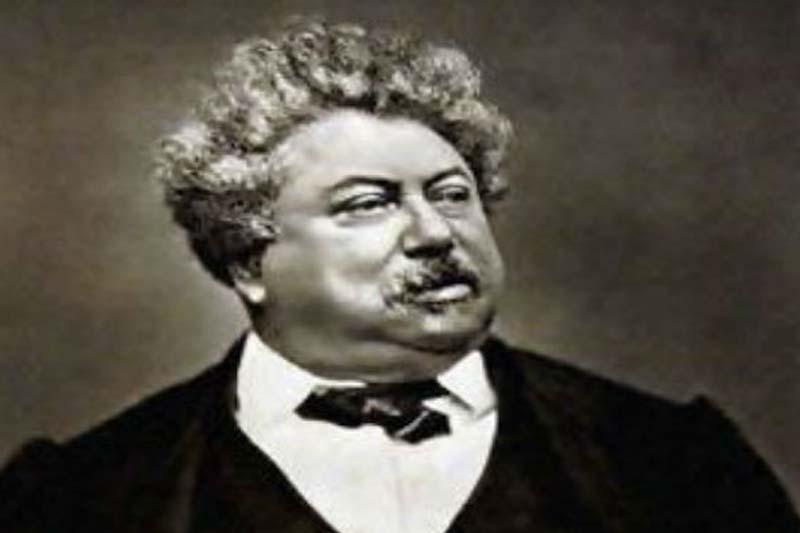The Adventures of Alexandre Dumas
By | December 26, 2018
Alexander Dumas. Source: (The Weekly Challenger)
Dumas Davy de La Pailleterie, more commonly known as Alexandre Dumas, was born in Viller- Cotterêts, France on July 24, 1802. Dumas was the son of Marie Louise Labouret and Thomas-Alexandre Davy de La Pailleterie. He had two older sisters, Marie-Alexandrine and Louise Alexandrine, though Louise-Alexandrine died before Alexandre was born. His father was born in Saint-Domingue, in what is now Haiti. He was the son of the Marquis Alexandre Antoine Davy de La Pailleterie and an enslaved Haitian woman named Marie- Césette Dumas.
Despite being born out of wedlock, Thomas-Alexandre was taken by his father to France where he later enlisted in Napoleon’s army under the name Dumas. He advanced quickly, becoming a general by the age of thirty-one. After having a disagreement with Napoleon in Egypt, Thomas-Alexandre left the country in March of 1799 only to be taken prisoner in Naples. He was released in 1801, but never received any compensation for his time in imprisonment nor was he able to obtain a new position in the military. As a result, the family struggled financially. Their situation grew even worse when Thomas-Alexandre died of stomach cancer on February 26, 1806, leaving Marie Louise to care for young Dumas and his sister alone.
General Thomas-Alexandre Dumas. Source: (Wikipedia)
In 1822, Dumas moved to Paris where he studied literature while working as a scribe for the Duke d’Orleans, who would later become King Louis-Philippe. He wrote several plays which proved immensely popular during the late 1820s and 1830s and his style was often likened to that of Victor Hugo. Some of his early plays include
Henry III (1829),
Napoleon Bonaparte (1831), and
Antony (1831). He also wrote essays, short stories, and novels, with a deep interest in crime and scandals. From 1839 to 1841, he collaborated on an eight-volume collection of essays, entitled
Celebrated Crimes, which featured famous criminals from history including Beatrice Cenci, Martin Guerre, and Karl Ludwig Sand, as well as Cesare and Lucrezia Borgia.
The Three Musketeers (1993) Source: (thefilmstage.com)
However, the works for which Dumas received the most success, and for which he continues to be well-known today, were his novels. Their popularity led to them being translated into other languages, including English.
Les Trois Mousquetaires, known in English as
The Three Musketeers, was published in 1844 and was the first of three novels in his D’Artagnan Romances. The other two were
Vingt ans après (
Twenty Years After), published in 1845, and
Le Vicomte de Bragelonne,
ou Dix ans plus tard (1847), which was split into three parts when published in English. Those three parts were
The Victim of Bragelonne,
Louise de la Valliere, and
The Man in the Iron Mask.
The Count of Monte Cristo (2002) Source: (unionfilms.org)
It was also at this time that he wrote
Le Comte de Monte Cristo (1844-45), which was published in English as
The Count of Monte Cristo. Among his lesser-known works were two romantic novel series. The Valois Romances consisted of three novels which followed the reign of Queen Marguerite, the last of the Valois; however, Dumas wrote four more novels concerning the family. The other series, the Marie Antoinette romances, consisted of eight novels. Dumas was responsible for one of the earliest werewolf-themed novels, entitled
The Wolf Leader. He also wrote two novels about Robin Hood,
Les Prince des voleurs (
The Prince of Thieves) and
Robin Hood le proscrit (
Robin Hood the Outlaw), both of which were published posthumously.
Château de Monte Cristo. Source: (Wikimedia Commons)
Dumas made a lot of money from his writing; however, he also spent a lot of money. He used some of it to build his home, the Château de Monte Cristo, in Port-Marly, Yvelines, France and was known to frequently entertain guests there, many of whom took advantage of his generosity. As a result, he had to sell the property two years later. Though he was married in 1840 to an actress named Ida Ferrier, he was known for having affairs and had at least two children, Alexandre Dumas fils and Marie Alexandrine, by different women. Due to his uncontrolled spending habits, Dumas was forced to flee in 1851 to evade creditors, first to Belgium and later to Russia.
Paris Metro Station. Source: (Wikipedia)
Dumas died at his son’s home in Puys, France, on December 5, 1870, and was originally buried in the cemetery of Villers-Cotterêts. Since his death, he has received several posthumous honors, including having a metro station in Paris named after him, and his former home, the Château de Monte Cristo, turned into a museum. In 2002, his remains were moved to the Pantheon in Paris and enshrined among other great authors like Victor Hugo and Jean-Jacques Rousseau. His novels continue to be widely read, having been translated into nearly one hundred languages and has inspired more than two hundred films. Several of his works have been found and published posthumously, with the most recent being
Le Chevalier de Sainte-Hermine (
The Last Cavalier), which was discovered in the Bibliotheque Nationale in Paris in the 1980s and published in 2008.







